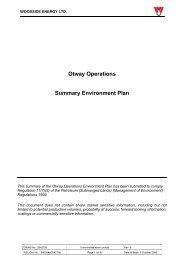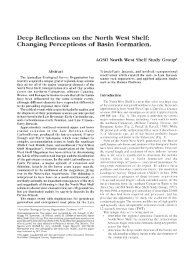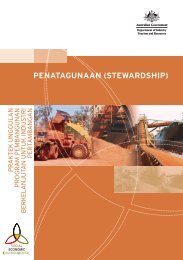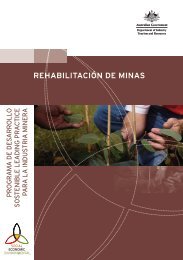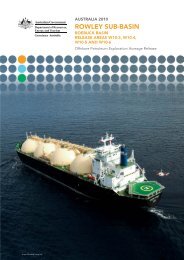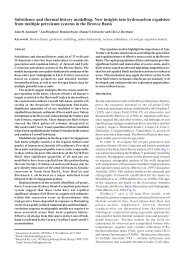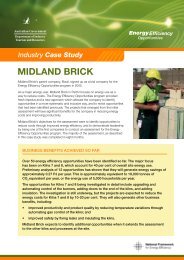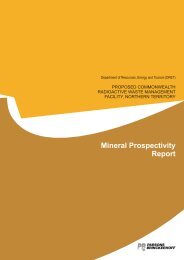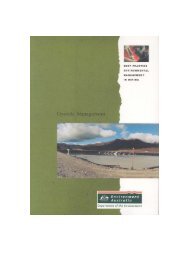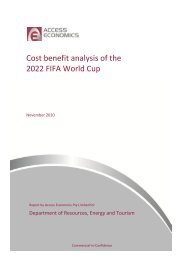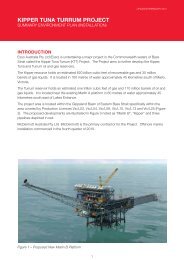A guide to leading practice sustainable development in mining
A guide to leading practice sustainable development in mining
A guide to leading practice sustainable development in mining
You also want an ePaper? Increase the reach of your titles
YUMPU automatically turns print PDFs into web optimized ePapers that Google loves.
<strong>in</strong>dica<strong>to</strong>rs of high importance dur<strong>in</strong>g construction may dim<strong>in</strong>ish <strong>in</strong> importance as the<br />
operation matures and the community adjusts <strong>to</strong> changed circumstances. While the<br />
fundamentals of a moni<strong>to</strong>r<strong>in</strong>g framework may rema<strong>in</strong> <strong>in</strong>tact for the life of the m<strong>in</strong>e,<br />
elements of a framework must be adjusted where necessary, <strong>to</strong> accommodate shifts<br />
<strong>in</strong> project life cycles, as well as expansions and contractions.<br />
M<strong>in</strong>e Rehabilitation Plann<strong>in</strong>g Dur<strong>in</strong>g<br />
Development and Construction<br />
Materials characterisation<br />
Both waste materials and ore that are <strong>to</strong> be excavated can offer opportunities and<br />
risks for rehabilitation. Characterisation of <strong>to</strong>psoils and overburden should start as<br />
early as the exploration phase and cont<strong>in</strong>ue through the pre-feasibility and feasibility<br />
phases as a basis for m<strong>in</strong>e plann<strong>in</strong>g. Early characterisation of materials enables<br />
plans <strong>to</strong> be developed <strong>to</strong> avoid potential risks and <strong>to</strong> ga<strong>in</strong> maximum benefit from<br />
material that may be particularly well-suited for construction for site <strong>in</strong>frastructure<br />
or for use <strong>in</strong> rehabilitation.<br />
Characterisation of these materials should be undertaken <strong>to</strong> ensure that they do not<br />
have the potential <strong>to</strong> create an adverse impact or prevent successful revegetation<br />
be<strong>in</strong>g achieved dur<strong>in</strong>g m<strong>in</strong><strong>in</strong>g or at closure. The requirement for characterisation<br />
cont<strong>in</strong>ues dur<strong>in</strong>g the operation of the m<strong>in</strong>e, particularly where the ore grade and<br />
m<strong>in</strong>e plan change <strong>in</strong> response <strong>to</strong> altered market conditions.<br />
M<strong>in</strong>e site structures such as run-of-m<strong>in</strong>e (ROM) pads, haul roads or contrac<strong>to</strong>r laydown<br />
areas should only be constructed us<strong>in</strong>g ‘benign’ materials. Where possible,<br />
these structures should be placed <strong>in</strong> already cleared areas <strong>to</strong> m<strong>in</strong>imise the amount of<br />
rehabilitation required.<br />
Closure Plann<strong>in</strong>g Dur<strong>in</strong>g Development and Construction<br />
It is essential that construction contrac<strong>to</strong>rs and personnel understand the<br />
implications that their activities may have for the eventual closure of the m<strong>in</strong>e.<br />
M<strong>in</strong>es can close dur<strong>in</strong>g the commission<strong>in</strong>g and construction stage due, for example,<br />
<strong>to</strong> budget overruns. Therefore activities disturb<strong>in</strong>g the site should be kept <strong>to</strong> a<br />
m<strong>in</strong>imum dur<strong>in</strong>g this phase. It is also important that local landowners and the<br />
local community are not unnecessarily <strong>in</strong>convenienced at this time and that the<br />
foundations for long-term relationships are built. Dur<strong>in</strong>g this phase, plann<strong>in</strong>g and<br />
design decisions can have long-term consequences for the environment, future<br />
land uses, community health and safety that will impact upon the m<strong>in</strong>e closure and<br />
completion process. For example:<br />
poor foundation construction for a tail<strong>in</strong>gs dam or water s<strong>to</strong>rage ponds can lead.<br />
<strong>to</strong> exacerbated long-term seepage and potential groundwater contam<strong>in</strong>ation.<br />
waste rock dumps designed <strong>to</strong> handle sulfidic waste need <strong>to</strong> have appropriate low.<br />
permeability foundations and/or acid consum<strong>in</strong>g material placed as a basal layer.<br />
78 LEADING PRACTICE SUSTAINABLE DEVELOPMENT PROGRAM FOR THE MINING INDUSTRY






